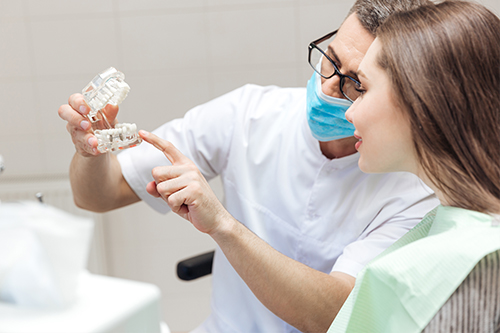Why quick action matters for dental emergencies
Not every dental problem needs immediate attention, but certain signs demand a rapid response. Intense, persistent pain; uncontrollable bleeding; sudden facial swelling; a tooth knocked completely out; or symptoms of spreading infection such as fever and increasing redness are all signals that waiting could make the situation worse. Rapid evaluation reduces the risk of permanent damage and helps protect both teeth and the surrounding tissues.
Speed matters because the mouth is closely connected to overall health. An untreated infection can move beyond the tooth and gums, potentially affecting breathing or swallowing and complicating medical conditions. Early intervention often simplifies treatment — what might require extraction and extensive reconstruction later can sometimes be managed with a conservative procedure if caught early enough.
When patients arrive for urgent care, the immediate goals are straightforward: relieve pain, control bleeding and infection, and protect vulnerable oral structures. Stabilizing the situation gives clinicians the time to plan an appropriate course of definitive care, whether that means repairing a tooth the same day or scheduling follow-up treatment to restore function and comfort.
Everyday emergencies we see and how they present
Dental emergencies show up in different ways. A severe toothache with throbbing pain that wakes you at night can indicate nerve inflammation or an abscess. Trauma from falls, sports, or accidents can produce cracked teeth, loosened teeth, or a tooth that’s been completely avulsed (knocked out). Restorations such as crowns or fillings can fail suddenly, creating sharp edges or exposing sensitive tissues that cause acute pain.
Soft-tissue injuries and rapidly spreading gum infections also require prompt attention. Cuts inside the mouth, lacerations to the lip or tongue, and sudden swelling around the gums can be both painful and disruptive to eating and speaking. Infections that produce facial swelling, difficulty opening the mouth, or trouble swallowing are especially concerning and should be evaluated without delay.
Some problems are less dramatic but still urgent: a temporary but severe change in bite, a broken denture causing sores, or acute discomfort from impacted wisdom teeth. Each of these presentations calls for a careful assessment to determine whether same-day intervention will resolve the issue or whether a staged treatment plan is safer and more effective.
How we evaluate urgency and decide what to do first
Assessment begins with a focused, practical exam designed to identify immediate risks. The clinician visually inspects the mouth, palpates areas of tenderness or swelling, and asks targeted questions about the onset and course of symptoms. Medical history and current medications are reviewed quickly to ensure any treatment is safe and well-informed.
Diagnostic imaging — usually targeted digital X-rays — is often used to see beneath the surface and confirm the source of pain or infection. These images help determine whether a tooth is fractured, whether an abscess is present, or whether bone and surrounding structures are involved. Imaging combined with the clinical exam allows the team to prioritize interventions that reduce danger and discomfort.
Triage decisions focus on immediate threats first: stopping significant bleeding, reducing dangerous swelling that affects breathing or swallowing, and controlling spreading infection. When possible, clinicians provide same-day solutions such as temporary restorations, suturing of soft-tissue injuries, or placement of medicated dressings. When definitive treatment can’t be completed immediately, a clear stabilization plan is put in place and explained to the patient.
Practical first-aid steps patients can take before arrival
While professional care is the priority, a few sensible measures can reduce pain and preserve treatment options before you reach the office. For bleeding, apply gentle pressure with clean gauze or a damp tea bag; the tannins in tea can support clotting in minor situations. For swelling, use an ice pack on the outside of the cheek in 10–15 minute intervals to limit inflammation and discomfort.
For a knocked-out tooth, time is critical. Pick up the tooth by the crown (the visible part), rinse it briefly with plain water if it’s dirty — do not scrub or remove tissue fragments — and, if you can, try to reinsert it into the socket. If reinsertion isn’t possible, keep the tooth moist by placing it in milk or a recommended tooth-preserving solution and come to the office immediately; appropriate handling greatly improves the chance of saving the tooth.
Avoid placing aspirin directly on a painful tooth or applying untested topical remedies that could mask symptoms or interfere with evaluation. Over-the-counter pain relievers can be used to manage discomfort; follow dosing instructions and tell the clinician what you took. Clear, calm communication about onset, severity, and any measures you’ve already tried helps the team triage and treat you effectively.
From immediate care to long-term solutions
After stabilizing the emergency, the treatment plan moves from short-term relief to durable restoration. When the tooth structure and root are salvageable, restorations such as bonding, onlays, or crowns can rebuild strength and appearance. If the tooth’s nerve is infected, root canal therapy often eliminates the infection while preserving the natural tooth and function.
When a tooth cannot be saved, extraction may become the safest option to protect surrounding tissues and stop infection. Fortunately, modern restorative options give patients reliable pathways to restore chewing ability and aesthetics — including implant-supported replacements, fixed bridges, or removable prostheses. The recommended approach depends on clinical findings, overall oral health, and the patient’s goals for function and appearance.
Throughout the process, we emphasize clear explanations and shared decision-making so patients understand the rationale for each step and what to expect from recovery and follow-up care. Proper aftercare and scheduled evaluations are essential to ensure that the immediate repair transitions into lasting oral health and comfort.
At Wonderful Smiles Dental our team approaches emergencies with urgency, experience, and a focus on practical outcomes. If you are experiencing severe dental pain, traumatic injury, or signs of infection, please contact us for more information or guidance on next steps. We are here to help you protect your oral health and restore comfort as quickly as possible.






